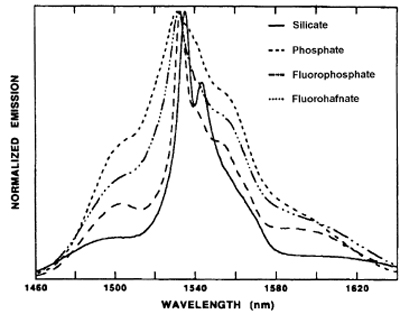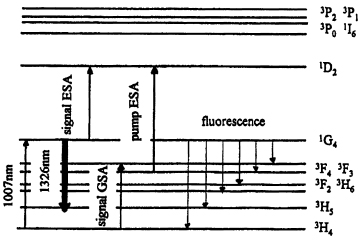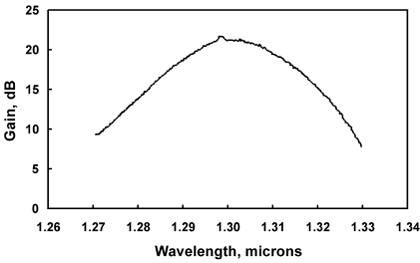Optipedia • SPIE Press books opened for your reference.
Fluoride glass optical fiber amplifiers
Excerpt from Infrared Fibers and Their Applications
Fluoride glasses were seen to be potentially excellent hosts for RE doping as early as 1978, when these hosts were being viewed as solid-state laser materials.2,3 One particularly attractive feature of the fluoride glass hosts is the large bandwidth of the emission spectra compared to the oxide glasses. In the excellent review article by Miniscalco,1 he shows the normalized emission band for Er3+ in oxide and fluoride glass hosts. His data is reproduced in Fig. 10.4, where it can be clearly seen that the bandwidth is much larger for the heavier fluorohafnate compared to the silicate glasses. However, the emission spectra and bandwidths shown in Fig. 10.4 may be influenced by reabsorption, so instead it is more valuable to look at the gain bandwidth. The gain bandwidth refers to the bandwidth of the actual gain that can be expected in a high-gain amplifier. The data in Table 10.1, taken from Miniscalco, shows that the FWHM bandwidth at 1550 nm for which the gain remains above some value, say 20 dB or more, can be significantly greater for the fluoride compared to the silica glasses.

Figure 10.4 1500-nm emission spectra for different glass hosts doped with Er3+. Note the variation in shape and linewidth for the various host glasses.1 [Reprinted with permission.]
HMFG has been dopedwith a wide range of RE ions, including themore important Pr3+, Er3+, Ho3+, Tm3+, and Nd3+ ions. Spirit et al.8 doped a 7.1-µm- core fluorozirconate fiber with 500 ppm Er3+ to amplify light in the 1550-nm band. A 1485-nm pump laser was used, and the length of the Er-doped fiber was 5 m. Using this fiber amplifier they were able to achieve a gain of 18 dB from 1530 to 1565 nm. This range compares favorably with the 40-nm range from an Er-doped, Al co-doped silica fiber. The only advantage to the fluoride host is that the gain spectrum is flatter than it is for silica hosts. The efficiency for the Er-doped ZBLAN or silica fiber hosts is about the same.
Table 10.1 1500-nm bandwidths for some Er3+-doped glasses.
| Glass | FWHM, nm | 20 dB peak | 30 dB peak | 40 dB peak |
| Al/P-doped silica | 43.3 | 7.9 | 6.4 | 5.3 |
| Fluorozirconate | 63.3 | 16.4 | 11.7 | 9.0 |
| Fluorohafnate | 63.8 | 17.3 | 13.2 | 10.4 |
While the results of Spirit et al. are encouraging, they are not appreciably better than those for Er-doped silica fibers. Furthermore, silica has much more favorable physical properties than fluoride glass, and, therefore, recent research on fluoride fiber amplifiers has turned from 1550 nm to the important, shorter- wavelength telecom band at 1300 nm where EDFAs do not operate. Probably the most important ion for fiber amplification at 1300 nm is Pr3+. The energy level diagram for Pr3+ is shown in Fig. 10.5.3 The important transition for amplification is 1G4 -> 3H5, but the 1G4 metastable state is largely depopulated by nonradiative (phonon) transitions; therefore, the quantum efficiency of this transition is only a few percent. While this system is not as efficient as the EDFAs, it nevertheless is a promising 1300-nm OFA. Ainslie et al.3 have doped ZBLAN fibers with 1000 ppm Pr3+ ions and studied their performance at 1300 nm. The gain bandwidth for a 24-m-long fiber longitudinally illuminated with a 1.047-µm 300-mW pump source is given in Fig. 10.6.3 The peak of the gain curve is at 1300 nm and the 3-dB bandwidth is 20 nm. This bandwidth is compatible with current telecom wavelengths.

Figure 10.5 Energy level diagram for Pr3+ for emission into the 1300-nm bands. [Reprinted from Ref. 3, Copyright 1995, with permission from Elsevier.]

Figure 10.6 Small signal gain for Pr3+-doped fluoride glass fiber amplifier with a 300-mW pump input power. [Reprinted from Ref. 3, Copyright 1995, with permission from Elsevier.]
Not all RE-doped fluoride fibers have applications as amplifiers for telecommunications systems. Fiber lasers were made from Nd3+-doped HMFG in 1987 by Brierly and France.4 These fiber lasers operated at 1.05 µm. A more efficient fiber laser was reported a year later by Brierly and France5 when they used Er-doped fluorozirconate fibers. The Er-doped MM fiber, 75 cm in length, was pumped by 476.5-nm radiation from an Ar ion laser. The cw output from the 4I11/2 -> 4I13/2 transition gives lasing action at 2.7 µm. Allen et al.6 also achieved lasing action at the same wavelength for Er:ZBLAN fibers. In their case they used a much more convenient 792-nm laser diode to pump the fiber. The maximum output power was about 2 mW and the efficiency was 8%. Finally, a more efficient and powerful fluoride fiber laser was reported by Percival et al.7 using a fluoride fiber co-doped with Ho3+ and Tm3+. Lasing action takes place from a transition in Ho. The Tm ions are pumped by diode laser light between 820 and 830 nm and then the energy is transferred to the Ho ions. The maximum cw output power was 250 mW at 2.024 µm, with a maximum slope efficiency of 60%.
References
- W. J. Miniscalco, "Erbium-doped glasses for Fiber Amplifiers at 1500 nm," J. Lightwave Tech., Vol. 9, pp. 234-250 (1991).
- M. C. Brierley and P. France, "Neodymium-doped fluorozirconate fibre laser," Electron. Lett., Vol. 23, pp. 815-817 (1987).
- R. Allen, L. Esterowitz, and R. J. Ginther, "Diode-pumped single-mode fluorozirconate fiber laser from the 4I11/2 to the 4I13/2 transition in erbium," Appl. Phys. Lett., Vol. 56, pp. 1635-1637 (1990).
- R. M. Percival, D. Szebesta, S. T. Davey, N. A. Swain, and T. A. King, "Thulium sensitized holmium-doped cw fluoride fibre laser of high efficiency," Electron. Lett., Vol. 28, pp. 2231-2232 (1992).
J. Harrington, Infrared Fibers and Their Applications, SPIE Press, Bellingham, WA (2003).
View SPIE terms of use.

